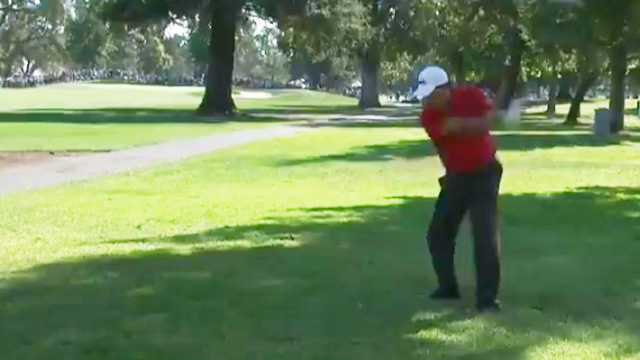NEWS
Phil Mickelson hit a screaming hook to get out of trouble and made birdie at the Safeway Open. Here's how you can do it, too.

Five-time major champion Phil Mickelson tied for third over the weekend in the PGA Tour's 2017-18 season-opening Safeway Open.
It was Lefty's first top-3 finish in a Tour event since his playoff loss to Henrik Stenson at the 2016 Open Championship.
The most amazing stat to come out of Mickelson's first top-3 finish with brother Tim on the bag is this one: He only hit 15 of 56 fairways for the week at Silverado Resort -- including five total in the final two rounds when he shot 6 under.
That means he absolutely scrambled his you-know-what-off.
After finding the short grass with tee shot on Sunday, Mickelson quipped, "Let's take a moment to admire the fact that I just hit a fairway."
Arguably his best shot of the week came on the 13th hole Saturday in Round 3.
After an ugly tee shot that hooked well right and into the trees, it was looking like Mickelson would be forced to pitch back out into the fairway sideways.
As we all know, however, that's not Mickelson's style.
Instead of playing to percentages, Mickelson decided to smoke a low-flying hook around the trees that were obstructing his view to the green. The ball hit the fairway hard and with the hook spin on the ball, rolled up onto the green to within 10 feet.
Minutes later, he'd hole the putt for what anyone else might consider an all-world birdie.
The gamble, like it often does for Mickelson on the course, paid off.
PGA.com tracked down 2013 PGA National Teacher of the Year Lou Guzzi to get his thoughts on the shot along with some tips in how you too can pull it off.
"The first thing that struck me with Phil in that spot is that there was zero indecisiveness," Guzzi said. "He knew exactly what he wanted to do and, given the way he executed it, it was clear that it's a shot he's played and practiced hundreds, probably thousands, of times. He was prepared to hit it. It was Seve Ballesteros-like."
Though hitting the shot like Mickelson did is no walk in the park, Guzzi said that with a little practice, it's not as hard as it looks.
"Golfers on the driving range always seem hung up on trying to hit the perfect, stock shot," he said. "Don't do that all the time. Visualize situations you're going to face on the golf course. Practice hitting all kinds of shots with your clubs -- hit them high, low, left and right and make a mental note of how the ball is reacting when it lands. For instance, if it's going to have a lot of hook spin like Phil's shot at the Safeway Open, you need to factor in how that ball is going scream and hook more when it hits the grass."
Guzzi says there are three factors to consider when you find yourself stuck in the trees:
1. Ask yourself: Can I get myself out of trouble, or do I have to pitch the ball back into play?
If you've decided you can get yourself out of trouble...
2. Decide where you want your ball to land -- not where you want it to end up.
3. Factor in what the ball is going to do once it hits the ground. Hitting a hard hook? It's likely to shoot the ball about another 15-20 yards with that hook spin, so make sure you've factored that in accordingly in step two.
"To hit a shot like this, you want to shut down the clubface," Guzzi said. "Place the ball in the back of your stance and try taking an 8-iron to start. Shut down that clubface and see there's just this incredible hook on the ball. For a right-handed golfer, it'll be the opposite of what Phil did on Saturday. Aim way right of your target and shut down the face so that when you swing, you'll get that incredible hook. Then, don't forget to really take in what that ball is doing once it hits the ground -- that hard hook spin is going to continue to shoot it left."
Go try it all out on the range and then the next time you find yourself in this position on the course, you won't have to dial up an attempted hero shot. Instead, you'll know exactly what you need to do and exactly what your ball will do.
